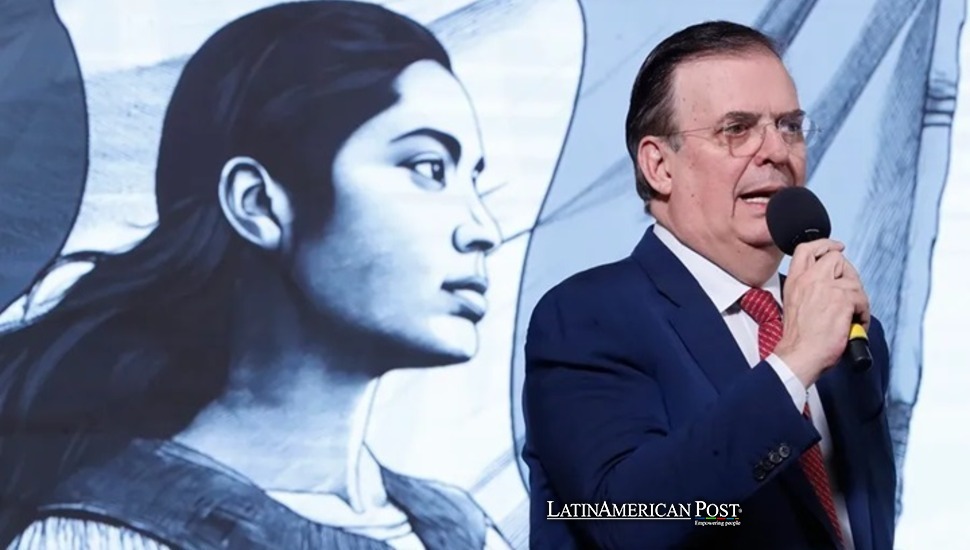Mexico’s New Economic Turmoil Amid US Tariff Uncertainty

Growing doubts about America’s planned import fees have disrupted Mexico’s financial outlook, causing unease among economists. The nation’s leaders maintain their stance against a slowdown, yet updated calculations from international banks and market experts point to concerns spreading through Mexico’s tender steps toward stability.
Revised Forecasts and Fears
In recent times, Mexico’s economy has been suspended between consistent purchases from North America and occasional rifts in commerce. Rising threats of additional trade charges at US boundaries cause distress about expected profits since financial experts predict negative effects in cases where such tariffs persist. Despite Mexico’s published 2025 budget expectations of 2.5 % economic growth, top research banks reduced their predictions in response to market instability and signs of decline.
These worries follow recent data showing Mexico’s economy grew 1.5% in 2024, a figure dampened by the final quarter, which registered a -0.6% dip—its first quarterly downturn in three years. Put differently, Mexico’s economy showed a decline in advance of the trade disputes. At present, the country faces more dangers from foreign influences than it has throughout the past decade.
The World Bank set its 2025 GDP growth projection for Mexico at 1.5%, while the private sector consensus, as published by the Bank of Mexico (Banxico), suggested a mere 1.07%. According to Moody’s less favorable outlook, Mexico faces a 0.6 % growth rate reduction, marking it as the primary target of US tariff impacts. Bank of America adjusted its numbers down to 0.8 %. These cuts in projections suggest the government’s 2.5 % goal exceeds realistic levels.
The research team found multiple barriers apart from import fees: reduced corporate investment, confusing regulations governing power firms, and delays across supply chains. Challenges in commerce remain at the forefront of all issues. The nation stays subject to international financial shifts because of Mexico’s connection to United States markets, which comprise four-fifths of its total exports. A potential 25% tariff on steel, aluminum, or other categories could dramatically alter export flows, hamper economic expansion, and spark inflationary pressures.
The crisis deepened when Standard & Poor’s (S&P) asserted that a 25% tariff would likely induce recession in Mexico. BBVA predicted a contraction of up to 1.5% if such measures remain in effect “for most of the year,” Banamex projected a worst-case scenario of a 2.2% downturn. Even smaller or temporary levies could ripple through the economy in this climate. The official line from Mexico’s Finance Ministry (SHCP) is that a moderate slowdown is likely but that a full-blown recession remains off the table. Nevertheless, tension escalates as each day passes without clarity on when or if the threatened tariffs might be enforced.
The Tariff Threat: US Policies and Mexican Responses
The potential 25% tariffs announced by the US administration under President Donald Trump first sparked alarm in late 2024, when the White House hinted it would penalize countries deemed uncooperative in curbing drug and migrant flows. Trump initially scheduled the duties for early 2025, but deadlines have shifted multiple times. Some announcements encompassed steel and aluminum imports—fields where Mexico ranks among the top suppliers to the US.
On the one hand, Mexican President Claudia Sheinbaum has taken steps to address these threats. In a notable compromise, Mexico offered to deploy 10,000 elements of the new National Guard (GN) at its northern border to regulate drug trafficking and migration. The agreement calmed both sides for 30 days, stopping the tax increases from taking effect. However, Trump kept saying that Mexico did not meet his standards, and his staff told reporters that they would take extra steps if Mexico failed to help as expected.
Such back-and-forth left companies in distress. Many remain uncertain whether the US will apply tariffs broadly or target specific sectors. While steel and aluminum appear first in line, agricultural goods, automotive components, and other key industries might face increased duties down the road. Such an extension could devastate supply chains that have relied on the free flow of goods across the US-Mexico border under existing trade agreements.
Recent instability has tumultuous Mexico’s money markets, suggesting that interest rates need adjustment. The central bank faces a choice: a drop in the peso’s value leads to price increases, forcing interest changes that slow business growth. In response, business leaders ask for direct talks to shield the car, electronics, and food industries. However, only signed papers or binding deals will reduce fears about high import fees.
The current leader, who promised a stable treasury and effective tax management, faces decreasing support from citizens if international conditions damage Mexico’s troubled financial landscape. At the same time, local advocates warn that ramped-up security measures at the northern border—such as a heavier military presence—could foster human rights abuses against migrants and strain resources. This places Mexico’s government in a predicament: balancing US demands with domestic constitutional and humanitarian obligations.
Potential Consequences: Inflation, Supply Chains, and Investment
Tariffs of 25% on steel and aluminum and other proposed levies could be significant for Mexico’s supply chains. Over 82% of Mexico’s steel and aluminum exports go to the United States, representing about 2.1% of total national exports in 2024. Although that figure might appear modest, it underscores an industry deeply interwoven with North American networks. The introduction of sudden policy shifts creates problems for revenue streams and factories with precise production schedules that need supplies from other countries on exact timetables.
However, additional industries will face exposure if the United States adds trade barriers against car components, industrial equipment, digital devices, and food items. Mexico’s role as a leading car parts manufacturer means that American companies depend heavily on quick-turnaround shipments from Mexican plants. If those flows encounter a 25% hike in cost, auto assembly lines could confront immediate and widespread disruptions, driving up consumer prices and potentially curbing demand. Similar logic applies to agricultural products—should the White House decide to penalize imported fruits, vegetables, or meats, American grocers and restaurants might see their costs spike.
Higher tariffs also threaten to impose inflationary pressures on both sides of the border. For US consumers, goods sourced from Mexico would become more expensive. The peso faces pressure from international investors who doubt Mexico’s ability to sell products abroad, which leads to higher prices in stores for goods from other countries. In contrast to what financial specialists say about Mexico’s trade diversification, selling products to new international markets creates obstacles. Mexican manufacturing plants and commercial enterprises maintain deep links with American businesses from decades of commerce between the two nations. Thus, short-term dislocations appear inevitable.
Mexican industries reliant on foreign capital may also see investment slow or reroute. If US tariffs set off a wave of protectionism, Mexico’s once-promising position as a manufacturing gateway faces a formidable test. New or expanding companies might hesitate to put down roots if they fear repeated political storms that raise cross-border trade costs. Some businesses could explore alternative markets or shift to nations with more stable trade environments. From this observation spot, Mexican leaders face a need to handle rising political risks because of trade limits that loom ahead.
However, across American borders, numerous organizations oppose what the administration decided about trade. Many American firms, especially those tied to integrated North American supply chains, have expressed frustration, pointing out that tariffs would impose cost burdens on US manufacturers and create inflation for American consumers. US lawmakers from border states likewise caution that any disruption to the binational economy would prove deeply damaging to communities on both sides. This political wrangling means that even though talk of tariffs escalates, implementing them could spark a fierce backlash from industries and consumers domestically in the US.
Uncertainty Continues: Looking Ahead to Possible Scenarios
Until the US administration delivers a final verdict, Mexico remains in limbo. Economists paint several possible outcomes, each depending on the degree to which tariffs are enacted and the timeframe of their enforcement:
Short-Term Tariffs with a Quick Resolution: Political pressure from US businesses and broader global market concerns might prompt the White House to scale back or limit tariffs in the rosiest scenario. An agreement could quickly restore a sense of calm, spurring a modest rally in Mexican financial markets. Growth would remain anemic but likely avoid an outright recession if tensions ease by mid-2025.
Extended Tariff Uncertainty: A more precarious track involves repeated threats and short-term postponements with no definitive resolution. In this environment, Mexico would endure months of economic whiplash—businesses might postpone new investments, global agencies would further downgrade forecasts, and the peso could remain volatile. Even if the worst-case scenario never materializes, confidence could erode sufficiently to stifle job creation and domestic spending.
Major Tariffs Imposed for Most of 2025: Should the US impose 25% duties substantially, the negative ripple effects could be swift. BBVA’s projection suggests an economic contraction of 1.5% if tariffs hold for most of the year. S&P calls it a “recession,” while Banamex estimates a 2.2% slump in the harshest scenario. Consumer confidence, already wavering, might sink further, triggering reduced domestic consumption and intensifying the downturn.
Expanded Tariffs on Additional Sectors: The administration in Washington faces one threatening option: putting trade barriers on many products from Mexico, which includes car components, electronic devices, and food from farms. The resulting supply chain disruptions might tip Mexico and other regions of the United States into an economic slowdown. Mexico’s growth would falter more severely, potentially sparking an authentic crisis reminiscent of past monetary collapses—though improved foreign reserves might offer a cushion against total meltdown.
Against this backdrop, Mexico’s leadership aims to keep markets calm. Finance Minister Rogelio Ramírez de la O recently reassured international investors that “a recession is not within the forecasts of the Finance Ministry,” underscoring how official policy envisions resilience. However, controlling the narrative remains difficult with each new tweet or statement from the US administration. Moody’s, S&P, and other agencies watch developments carefully, adjusting their analyses if any definitive policy emerges from Washington.
At a grassroots level, citizens face a sense of déjà vu. For decades, Mexico has grappled with external shocks—whether oil crises, currency devaluations, or political unrest in major trading partners. Each time, the economy emerged battered yet persistent. Despite recent challenges, various factors make the situation more complex. Changes in government, the rise of computer-based commerce, and battles for market share increase pressure on both sides. The US market remains central to Mexican factories, which makes any disruption hurt more than before.
Mexico’s relationship with the US administration draws attention as President Claudia Sheinbaum reviews her next steps, particularly regarding border control cooperation. However, critics point to risks of reduced sovereignty in return for quick economic gains. In addition to tighter restrictions at crossing points, the leadership meets resistance from the population and objections by human rights advocates. The mix of diplomatic ties, domestic sentiment, and commercial interests requires a balanced approach to decision-making.
Numerous observers trust that reason will guide decisions. Protective tariffs can backfire on American consumers and industries, and the US administration could be swayed by internal dissent. US importers of Mexican steel, aluminum, produce, and manufactured goods have already voiced alarm. They underscore how integrated supply chains reduce consumer prices and bolster competitiveness in a global market. Indeed, the negative consequences of a significant tariff or trade blockade could be so substantial that neither side may find it worthwhile.
One factor that might help mitigate fallout is Mexico’s trade stance is not entirely US-centric. Mexico has forged deals with Europe, Asia, and other Latin American nations. If the White House escalates protectionist measures, the Mexican government may expedite deeper trade ties with alternative partners, though replacing the US market in scale remains daunting. Diversification could provide a partial hedge, lessening the blow of a US downturn in the longer term. Yet, American demand remains crucial in the short run, especially for higher-value manufactured exports.
The public across borders watches this economic conflict with doubt and unease. During recent years, nations everywhere faced setbacks from COVID-19, delayed shipments next to steep costs for basic goods. Through decades of trade, Mexico and the US built deep connections as neighbors, yet their latest dispute over taxes brings new problems in a period marked by economic weakness. In effect, a trade skirmish in North America could reverberate beyond regional boundaries, affecting everything from foreign exchange rates to investor sentiment in emerging markets.
As long as the White House stance remains unpredictable, the business environment in Mexico will remain overshadowed by doubts. Companies might hold off on expansions or new hiring. Capital flight causes interest rates to rise. Without a lasting agreement, economic decline deepens, damaging citizens’ faith in their leaders’ crisis management—a last-minute agreement to prevent tariffs leaves lingering effects from extended periods of market doubt.
Mexico’s economic difficulties show that trade disputes trigger immediate market instability, no matter the outcome. People pay attention to every word from the US capital, from street vendors to international analysts. Despite the slow pace of American policy shifts, these talks cause daily problems. The big credit rating firms and banks cut their estimates and point to economic troubles ahead. But the government in Mexico City insists this downturn won’t last.
In charge of Mexico’s money matters, officials face a tangled mess. The financial talks blend with debates about the border and narcotics next to people moving between countries. At the frontier, countless shops and businesses add up what a quarter increase in taxes means for them. Citizens fear job losses or price hikes daily should the standoff escalate. For the foreseeable future, trade watchers predict further diplomatic twists, last-minute adjustments, and extended deadlines.
Also Read: Mexico Secures Urgent Trump Pact to Postpone Tariff Imposition
No single policy or statement can erase the structural vulnerabilities born from Mexico’s heavy reliance on the US market. The immediate results depend on negotiations between leaders. Yet, Mexico faces a more fundamental challenge: how to build multiple economic channels and create stability despite recurring pressure from its northern neighbor. A mix of optimism and wariness prevails across the nation, as its people understand that extended discussions about trade fees damage trust and point to difficult months ahead. If calmer solutions prevail, Mexico might salvage its slow but steady progress. If not, the specter of recession looms more menacingly than ever before.





